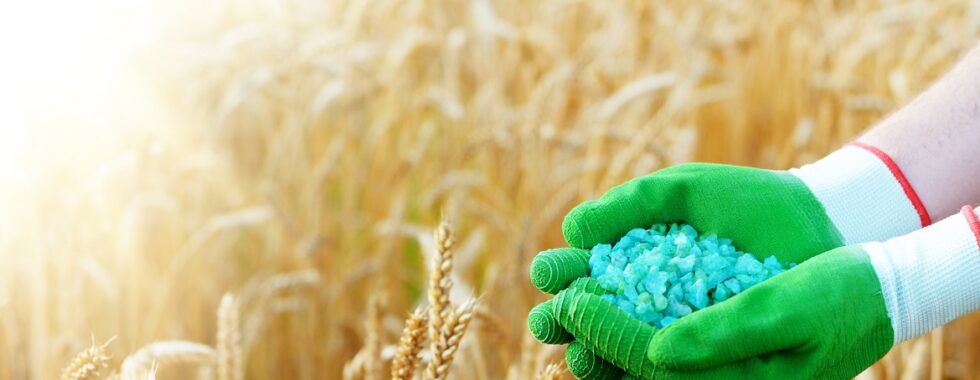Slow and controlled-release fertilizers
Slow-release (SRF) and controlled-release fertilizers (CRF) are compounds designed to supply the crop with nutrients, in a rate that meets its nutrient demand. Unlike quick release fertilizers (QRF) that quickly dissolve in the soil and provide nutrients for a relatively short period of time, slow-release, and controlled-release fertilizers release nutrients over a longer period of time.
The advantages of SRF and CRF include:
- Enhanced nutrient-use efficiency
- Decreased nutrient leaching and nitrogen losses by volatilization
- Decreased environmental pollution risk
- A smaller number of applications is required
Under certain soil and weather conditions, nitrogen losses may occur due to leaching, volatilization, runoff, and denitrification. Such losses not only affect the crop, but they also pose a major environmental concern. Nitrate contamination of water resources and emissions of nitrous oxide to the atmosphere are considered a serious environmental risk.
Crops take up nutrients at a certain rate throughout their growing cycle. Applying a large dose of fertilizer at the beginning of the crop cycle may result in nutrient losses before the crop can use them. Therefore, in order to avoid losses and meet the nutrient requirements of the crop, quick release fertilizers must be applied in several split applications.
Slow and controlled-release fertilizers can be an alternative to the split applications. They improve the nutrient use efficiency (NUE) by releasing nutrients at a slow rate, extending the availability of the nutrient, and minimizing potential losses. Ideally, the release rate should match the nutrient uptake rate of the crop, so that nutrients become available as the crop needs them.
From an economical perspective, although SRF and CRF are more expensive than conventional fertilizers, reducing the fertilizer application frequency saves labor and energy costs.
What is the difference between slow-release fertilizers and controlled-release fertilizers?
Slow-release fertilizers contain nutrients in a form that is not immediately available to plants. They may contain macro nutrients (nitrogen, potassium phosphorus) as well as micronutrients (iron, manganese, zinc, copper etc.) . The most common slow-release fertilizers include nitrogen fertilizers in which urea is combined with an aldehyde. Urea formaldehyde (UF), Nitroform (UF derivative), methylene urea (MU) are examples of such fertilizers.
To release available nitrogen, SRF must be broken down by microorganisms. Therefore, the rate of release depends on the activity of microorganisms in soil and, hence, on soil moisture and temperature.
Other SRF, such as IBDU (Isobutylidendiurea) are not dependent on microbial activity and decompose by hydrolysis. The slow-release effect is achieved due to their low solubility.
Plant manures, animal manures and compost are considered as natural sources of slow-release fertilizers. However, their nutrient release rate is usually very slow and highly depends on microbial activity.
Controlled-release fertilizers refer to coated fertilizers or to matrices. Coated fertilizers are coated either with a polymer or with an inorganic materials, such as sulfur. Using the matrices technique, the matrix is dispersed within the fertilizer and slows down its dissolution. The materials used for the matrix include rubber, polyolefins, or gel-forming polymers.
The nutrient release pattern of slow-release fertilizers depends on soil conditions and on the activity of microorganisms and, therefore, is difficult to predict. The nutrient release pattern of controlled-release fertilizers can be better predicted, as it is not significantly affected by soil conditions such as pH, microbial activity, salinity etc., but rather by soil temperature and the properties of the coating materials.
Sulfur-coated urea is classified as a ‘slow-release fertilizer’ because the nitrogen release rate might be inconsistent. Cracks in the coating may cause a release of over 30% of the nitrogen immediately.
Join the “Fertilization and irrigation at an expert level” online course by Guy Sela.
The nutrient release pattern
SRF and CRF can be further classified according to their nutrient release pattern, which can be either linear or sigmoidal (S-shaped pattern). The sigmoidal pattern consists of an initial period in which only a small amount of nutrient is released, a linear release stage and a final release stage, in which the release rate decreases. In CRF, the release duration and pattern can be controlled by the selection of the coating materials, the specific ratio between the polymers, the thickness of the coating and particle size.
 Sigmoidal nutrient release pattern
Sigmoidal nutrient release pattern
The coating acts as a semi-permeable membrane. The controlled-release effect is achieved when water diffuses through the coating and slowly dissolves the nutrients. Diffusion rate and solubility are affected by soil temperature, where higher temperatures result in a higher release rate.





